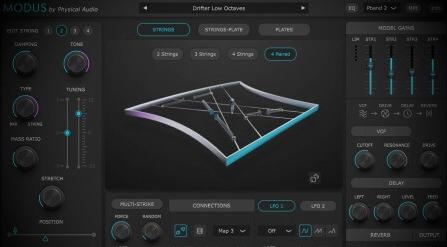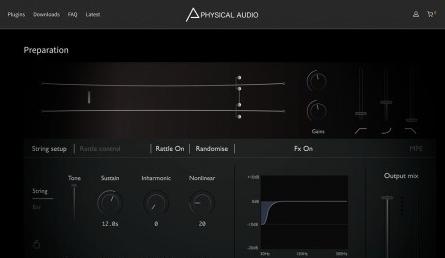Physical Audio Modus v1.0.4 WiN
Soft / VST Instruments / VST Effects
21-07-2023

Enter a sonic imaginarium where hard physics meets soft synth processing. Modus is a virtual world of conceptual instruments, modelled with cutting edge physical behaviours and acoustic properties.
Unreal instruments
Modus uses our latest research in collision modelling to connect acoustic elements together. Strings, plates, springs and rattles collide, literally, in algorithmic air to generate tones that resonate and react just like they would outside the virtual realm. These elements are combined in different ways to create three types of instruments.
Connected Strings
Each voice has up to four connected strings which can be plucked or act as resonators. The strings are connected by either rattles that give collision effects as the strings vibrate, or nonlinear springs. Physical parameters control the decay, mass and harmonic content along with individual semitone and fine tuning controls.
Strings connected to a Plate
This model has two strings connected to a plate using nonlinear connections that can either be rattles or springs. These strings are retuned on-the-fly to give 6 octaves of monophonic or duophonic sound. The plate can act as a soundboard by varying its decay, mass and fundamental frequency. These, along with the connection controls, can all be changed in real-time.
Driven Plates
A driver signal is used to excite the top plate, which is connected to the bottom plate with two nonlinear connections. This driver can be a polyphonic sawtooth or sine wave, or a multi-striking hit for percussive effects. There is also an option to use a single plate connected to ground.
home page:
https://goo.su/wNsF
Unreal instruments
Modus uses our latest research in collision modelling to connect acoustic elements together. Strings, plates, springs and rattles collide, literally, in algorithmic air to generate tones that resonate and react just like they would outside the virtual realm. These elements are combined in different ways to create three types of instruments.
Connected Strings
Each voice has up to four connected strings which can be plucked or act as resonators. The strings are connected by either rattles that give collision effects as the strings vibrate, or nonlinear springs. Physical parameters control the decay, mass and harmonic content along with individual semitone and fine tuning controls.
Strings connected to a Plate
This model has two strings connected to a plate using nonlinear connections that can either be rattles or springs. These strings are retuned on-the-fly to give 6 octaves of monophonic or duophonic sound. The plate can act as a soundboard by varying its decay, mass and fundamental frequency. These, along with the connection controls, can all be changed in real-time.
Driven Plates
A driver signal is used to excite the top plate, which is connected to the bottom plate with two nonlinear connections. This driver can be a polyphonic sawtooth or sine wave, or a multi-striking hit for percussive effects. There is also an option to use a single plate connected to ground.
home page:
https://goo.su/wNsF
Related articles
 Physical Audio Modus v1.0.2 WiN
Physical Audio Modus v1.0.2 WiN
Soft / VST Instruments / VST Effects
12-07-2023
Enter a sonic imaginarium where hard physics meets soft synth processing. Modus is a virtual world of conceptual instruments, modelled with cutting edge physical behaviours and acoustic properties.
Unreal instruments
Modus uses our latest research in collision modelling to connect acoustic elements together. Strings, plates, springs and rattles collide, literally, in algorithmic air to generate tones that resonate and react just like they would outside the virtual realm. These elements are combined in different ways to create three types of instruments.
Unreal instruments
Modus uses our latest research in collision modelling to connect acoustic elements together. Strings, plates, springs and rattles collide, literally, in algorithmic air to generate tones that resonate and react just like they would outside the virtual realm. These elements are combined in different ways to create three types of instruments.
 Physical Audio Preparation v1.1.8 WiN
Physical Audio Preparation v1.1.8 WiN
Soft / VST Instruments / VST Plugins
12-07-2023
Preparation is a physical modelling instrument based on nonlinear models of strings and collisions.
Physical modelling of prepared strings
Preparation is based on mathematical modelling of 2 basic elements; strings which can be configured as bars, and a rattling element. Each voice has a pair of strings connected by a rattle that reacts to the vibrations at each end. This uses the latest research in collision modelling to calculate the acoustic system in real-time. The strings have parameters for nonlinearity, inharmonicity, sustain and tone. The rattle has controls for the mass at each end, the gap from the strings, the stiffness, edginess, strength and its position. A low shelf EQ, overdrive and reverb units complete the signal chain, giving a wide range of sounds from cutting leads to epic soundscapes. See this tutorial post for further details.
Physical modelling of prepared strings
Preparation is based on mathematical modelling of 2 basic elements; strings which can be configured as bars, and a rattling element. Each voice has a pair of strings connected by a rattle that reacts to the vibrations at each end. This uses the latest research in collision modelling to calculate the acoustic system in real-time. The strings have parameters for nonlinearity, inharmonicity, sustain and tone. The rattle has controls for the mass at each end, the gap from the strings, the stiffness, edginess, strength and its position. A low shelf EQ, overdrive and reverb units complete the signal chain, giving a wide range of sounds from cutting leads to epic soundscapes. See this tutorial post for further details.
VST Plugins / Audio Soft
17-10-2021
Derailer is a physical modelling instrument plugin built from mathematical models of strings, bars and spring connection elements.
Physical modelling system
Derailer is a physical modelling system built from 3 basic elements. Strings which can be plucked or bowed, metal bars which can be pitched or act as resonators, and nonlinear springs which can be used to connect resonators together to form a network.
Driver
Soft / VST Plugins
28-09-2021
Derailer is a physical modelling instrument plugin built from mathematical models of strings, bars and spring connection elements.
Physical modelling system
Derailer is a physical modelling system built from 3 basic elements. Strings which can be plucked or bowed, metal bars which can be pitched or act as resonators, and nonlinear springs which can be used to connect resonators together to form a network.